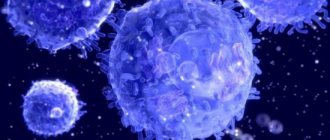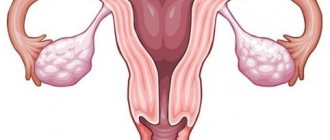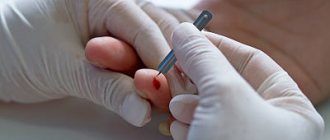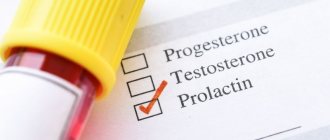Detailed description of the study
Karyotyping (cytogenetic examination) is an analysis to identify violations of a person’s chromosome set. Karyotyping reveals the number and structure of chromosomes, which makes it possible to identify chromosomal abnormalities that can cause infertility, miscarriage, other hereditary diseases and the birth of a sick child.
Each organism is characterized by a certain set of chromosomes, which is called a karyotype. The human karyotype consists of 46 chromosomes - 22 pairs of autosomes and two sex chromosomes. Women have two X chromosomes (karyotype: 46, XX), and men have one X chromosome and the other Y (karyotype: 46, XY). Each chromosome contains genes responsible for heredity. Karyotype research is carried out using cytogenetic and molecular cytogenetic methods. Outside the process of cell division, the chromosomes in its nucleus are located in the form of an “unpacked” DNA molecule, and they are difficult to view with a light microscope. In order for chromosomes and their structure to become clearly visible, special dyes are used to identify heterogeneous (heterogeneous) regions of chromosomes and analyze them - determine the karyotype. Chromosomes in a light microscope at the metaphase stage are DNA molecules packed into dense rod-shaped structures. Thus, a large number of chromosomes are packed into a small volume and placed in a relatively small volume of the cell nucleus. The arrangement of chromosomes visible in the microscope is photographed and from several photographs a systematic karyotype is collected - a numbered set of chromosomal pairs of homologous chromosomes. In this case, the chromosome images are oriented vertically, with short arms up, and their numbering is carried out in descending order of size. A pair of sex chromosomes is placed at the very end of the image of the chromosome set. Modern karyotyping methods provide detailed detection of chromosomal aberrations (intrachromosomal and interchromosomal rearrangements), violations of the order of chromosome fragments - deletions, duplications, inversions, translocations. Such a karyotype study makes it possible to diagnose a number of chromosomal diseases caused by both gross violations of karyotypes (violation of the number of chromosomes), and a violation of the chromosomal structure or a multiplicity of cellular karyotypes in the body. Disturbances of the normal karyotype in humans occur in the early stages of development of the organism. If this occurs in the germ cells of future parents, then the karyotype of the zygote formed by the fusion of parental cells also turns out to be disrupted. With further division of such a zygote, all cells of the embryo and the organism that develops from it will end up with the same abnormal karyotype. However, karyotype abnormalities can also occur in the early stages of zygote cleavage. The organism developed from such a zygote contains several cell lines (cell clones) with different karyotypes. Such a variety of karyotypes throughout the body or only in some of its organs is called mosaicism. As a rule, karyotype disorders in humans are accompanied by various, including complex, developmental defects, and most of these anomalies are incompatible with life. This leads to spontaneous abortions in the early stages of pregnancy. However, a fairly large number of fetuses (~2.5%) with abnormal karyotypes are carried to term until the end of pregnancy. Chromosomal abnormalities in newborns are the cause of 45-50% of multiple congenital malformations, about 35% of cases of mental retardation and 50% of absent menstruation in women. In adults, chromosomal abnormalities may not be clinically manifested at all, or may occur in erased forms. Often a person considers himself absolutely healthy and is not aware of any genetic disorders. But he cannot have children. Therefore, a study of the karyotype of blood lymphocytes is recommended for all infertile couples.
Any population of dividing cells can be used for the karyotype determination procedure.
.
To determine the human karyotype, either mononuclear leukocytes extracted from a blood sample, the division of which is provoked by the addition of mitogens, or cultures of cells that rapidly divide normally (skin fibroblasts, bone marrow cells) are used. The cell culture population is enriched by stopping cell division at the metaphase stage of mitosis by adding colchicine
, an alkaloid that blocks the formation of microtubules and the “stretching” of chromosomes to the poles of cell division and thereby preventing the completion of mitosis.
The resulting cells at the metaphase stage are fixed, stained and photographed under a microscope.
;
from the set of resulting photographs, a systematic karyotype
- a numbered set of pairs of homologous chromosomes (autosomes), the images of the chromosomes are oriented vertically with short arms up, they are numbered in descending order of size, a pair of sex chromosomes is placed at the end of the set.
Historically, the first non-detailed karyotypes that made it possible to classify according to chromosome morphology were obtained using Romanovsky-Giemsa staining, but further detailing of the chromosome structure in karyotypes became possible with the advent of differential chromosome staining techniques. Classical and spectral karyotypes
Classical and spectral karyotypes
To obtain a classic karyotype, chromosomes are stained with various dyes or their mixtures: due to differences in the binding of the dye to different parts of the chromosomes, staining occurs unevenly and a characteristic banded structure is formed (a complex of transverse marks, English banding), reflecting the linear heterogeneity of the chromosome and specific for homologous pairs chromosomes and their sections (with the exception of polymorphic regions, various allelic variants of genes are localized). The first chromosome staining method to produce such highly detailed images was developed by the Swedish cytologist Kaspersson (Q-staining). Other dyes are also used, such techniques are collectively called differential staining of chromosomes: Q-staining - Kaspersson staining with quinine mustard with examination under a fluorescent microscope. Most often used for the study of Y chromosomes (rapid determination of genetic sex, detection of translocations between the X and Y chromosomes or between the Y chromosome and autosomes, screening for mosaicism involving Y chromosomes)
G-staining
— modified Romanovsky-Giemsa staining. The sensitivity is higher than that of Q-staining, therefore it is used as a standard method for cytogenetic analysis. Used to identify small aberrations and marker chromosomes (segmented differently than normal homologous chromosomes)
R-staining
— acridine orange and similar dyes are used, and areas of chromosomes that are insensitive to G-staining are stained. Used to identify details of homologous G- or Q-negative regions of sister chromatids or homologous chromosomes.
C-staining
— used to analyze the centromeric regions of chromosomes containing constitutive heterochromatin and the variable distal part of the Y chromosome.
T-staining
— used to analyze telomeric regions of chromosomes.
Karyotype analysis
Comparison of complexes of transverse marks in classical karyotypy or areas with specific spectral characteristics makes it possible to identify both homologous chromosomes and their individual sections, which makes it possible to determine in detail chromosomal aberrations - intra- and interchromosomal rearrangements, accompanied by a violation of the order of chromosome fragments (deletions, duplications, inversions, translocation). Such an analysis is of great importance in medical practice, making it possible to diagnose a number of chromosomal diseases caused by both gross violations of karyotypes (violation of the number of chromosomes), and violation of the chromosomal structure or multiplicity of cellular karyotypes in the body (mosaicism).
Interpretation of research results
Karyotype research allows you to determine the characteristics of chromosomes:
- form;
- quantity;
- dimensions;
- structure;
- belonging;
- constrictions;
- heterogeneity.
During the procedure, each fragment is photographed. After this, the sections are combined into one diagram to compare the karyotype with the norms. As a result, the causes of infertility are identified and a prognosis for the child’s health is given.
Conclusion options:
- 46, XY - normal male;
- 46, XX - normal female.
The main diseases caused by abnormalities in the karyotype:
| 47,XXY; 48.XXXY | Klinefelter syndrome | Polysomy on the X chromosome in men |
| 45X0; 45X0/46XX; 45.X/46.XY;46.X iso (Xq) | Shershevsky-Turner syndrome | Monosomy on the X chromosome, including mosaicism |
| 47,XXX; 48,XXXX; 49,ХХХХХ | Polysomy on the X chromosome | Most common trisomy X |
| 47,XX,+21; 47,ХY,+21 | Down's disease | Trisomy on chromosome 21 |
| 47,XX,+18; 47,ХY,+18 | Edwards syndrome | Trisomy on chromosome 18 |
| 47,XX,+13; 47,ХY,+13 | Patau syndrome | Trisomy on chromosome 13 |
| 46.XX, 5r- | Cry Cat Syndrome | Deletion of the short arm of chromosome 5 |
What does karyotyping reveal?
The interpretation of the karyotyping analysis is carried out by a geneticist. The analysis normally looks like 46XX or 46XY. But if any genetic pathology is detected, for example, the identification of a third extra chromosome 21 in a woman, then the result will look like 46XX21+.
What allows you to determine the analysis of the chromosome set:
- trisomy - the third extra chromosome in a pair (for example, Down syndrome);
- monosomy - one chromosome is missing in a pair;
- deletion - loss of a section of a chromosome;
- duplication - doubling of any fragment of a chromosome;
- inversion - reversal of a chromosome section;
- translocation - movement of sections (castling) of a chromosome.
For example, the discovery of a deletion in the Y chromosome is often the cause of impaired spermatogenesis and, consequently, male infertility. It is also known that deletions are the cause of some congenital pathologies in the fetus.
For the convenience of displaying the analysis result on paper when a change in the chromosome structure is detected, the long arm is written with the Latin letter q, and the short arm t. For example, if a woman loses a fragment of the short arm of chromosome 5, the result of the analysis will look like this: 46ХХ5t, which means cry-the-cat syndrome (a genetic disorder characterized by the characteristic crying of a child and other congenital disorders).
In addition, karyotyping allows you to assess the state of genes. Using this research method it is possible to identify:
- gene mutations that affect thrombus formation, which disrupts blood flow in small vessels during the formation of the placenta or implantation and can cause miscarriage/infertility;
- gene mutation of the Y chromosome (in this case it is necessary to use donor sperm);
- mutations of genes responsible for detoxification (low ability of the body to disinfect surrounding toxic factors);
- a gene mutation in the cystic fibrosis gene helps to exclude the possibility of this disease in a child.
In addition, karyotyping helps diagnose genetic predisposition to many diseases, for example, myocardial infarction, diabetes mellitus, hypertension, joint pathology, etc.
Cytogenetic studies
Dear patients! Please note that the services of the CNMT cytogenetic laboratory are complex, i.e. The final cost consists of several components. Check with operators and administrators for information!
Advantages of the cytogenetic laboratory CMNT:
- Efficiency: issuance of test results within two weeks from the moment of blood sampling, and in urgent cases - within a week; for prenatal diagnostics - the shortest time in the city - in just 2-15 days (depending on the type of study).
- Convenient location: there are four branches where you can donate blood - st. Pirogova 25/4 and Koptyuga Ave., 13 in Akademgorodok, Mr. Gorsky, 51 and st. Titova, 7.
- High level of service. Blood sampling is carried out without prior appointment throughout the week, seven days a week, from 8:30 to 10:30, and if necessary until 15:00 (on Pirogova 25/4)
- Reception of chorionic villi for examination during frozen pregnancy is carried out both on weekdays and on weekends (by prior arrangement)
- The result can be issued to a third party using a code word that is set by the patient
- The test result can be sent to the patient by email
Many congenital diseases are associated with quantitative and structural abnormalities of chromosomes and are called “chromosomal syndromes.” Among them are such well-known ones as Down, Edwards, Patau, Turner, Kleinfelter syndromes, associated with a violation of the number of chromosomes. In addition to quantitative disorders, a huge range of structural abnormalities of chromosomes is detected.
Main indications for karyotype research:
- reproductive problems (infertility, repeated miscarriages, stillbirth);
- amenorrhea in women;
- abnormal spermogram in men (azoospermia, oligospermia);
- developmental defects;
- delayed mental, physical, sexual, speech development in children;
- suspicion of chromosomal pathology based on the clinical picture.
Diagnostics for future parents
A karyotype study is strongly recommended for spouses planning childbearing to identify hidden chromosomal pathology of a balanced type.
It is enough to carry out the study once in a lifetime, since the karyotype does not change throughout life. The material for the study is venous blood.
After the study, the patient is given a conclusion. It contains a high-quality karyogram (photo of chromosomes arranged in pairs), a karyotype formula (a brief record of the cytogenetic diagnosis in accordance with existing international rules), a conclusion (decoding the karyotype formula), and, if necessary, recommendations of a cytogeneticist.
If a chromosomal pathology is detected, the patient is provided with a free consultation with a geneticist to obtain a timely prognosis in connection with the diagnosis.
Prenatal (prenatal) diagnosis of chromosomal disorders
Every 200th newborn has a chromosomal abnormality. Most of these anomalies are accompanied by mental retardation and developmental defects. Therefore, prenatal diagnosis of chromosomal disorders is of great importance.
The main indications for studying the fetal karyotype (prenatal diagnosis):
- ultrasound markers of chromosomal abnormalities in the fetus;
- the pregnant woman is over 35 years old;
- high risk of chromosomal pathology in the fetus according to the results of biochemical screening;
- familial carriage of chromosomal rearrangements;
- the presence of a chromosomal abnormality or multiple congenital malformations (MCDM) in a previous child or fetus in the family.
There are methods for analyzing fetal chromosomes in all trimesters of pregnancy, starting from 11 weeks. All of them are used in CNMT. The choice of method is determined by the stage of pregnancy, depending on which different tissues are used (chorionic villi, amniotic fluid or umbilical cord blood). The goal is the same - to exclude chromosomal pathology in the fetus.
All of these tissues are obtained invasively - using intrauterine intervention performed under ultrasound guidance in an operating room.
If there are indications for prenatal diagnostics, the pregnant woman is at increased risk for chromosomal pathology of the fetus. However, an increased risk in no way means pathology in the fetus (it is detected in 7-10% of cases). This only means that it is necessary to undergo diagnostics in order to exclude this pathology. Whether to undergo it is up to the woman herself to decide; the doctor can only give his recommendations. Pregnant women at risk should undergo genetic counseling. A qualified specialist will assess the risk, give a prognosis, recommendations and be sure to take into account contraindications for diagnostics.
If a pregnant woman has concerns about the possible presence of Down syndrome or other chromosomal abnormalities in the fetus, it should definitely be removed. Diagnostics can be carried out at the request of the woman in the absence of contraindications.
Fetal karyotype examination from 11 to 16 weeks
In order to resort to early termination of pregnancy when severe pathology is detected, it is important to carry out prenatal diagnosis of chromosomal pathology in the first trimester. In the early stages of pregnancy - from 11 to 16 weeks - chorionic villi are examined. The gestational age is determined using ultrasound.
Villus sampling occurs through the pregnant woman's abdomen under ultrasound control. At CNMT, villus biopsies are performed in the same building where the laboratory is located. A cytogeneticist is present in the operating room and immediately evaluates the material taken, which avoids repeated sampling after a few days. Transporting the chorion to the laboratory takes only a few minutes, which is a significant factor in obtaining the result of the study. The period for issuing a conclusion on the examination of diagnostic chorionic villi is 2-3 days.
The laboratory also conducts examination of chorionic villi in non-developing (“frozen”) pregnancies for a period of 5 to 16 weeks. This makes it possible in many cases to establish the reason why the pregnancy stopped developing (with a “frozen” pregnancy, in 70-75% of cases a chromosomal pathology is detected in the fetus). Detection of pathology in the fetus in some cases is an indication for karyotyping of the parents. This study is very important for predicting future childbearing in a given couple. Chorionic villus sampling is performed by a gynecologist.
Fetal karyotype examination from 15 to 20 weeks
Amniocentesis (examination of fetal chromosomes in amniotic fluid cells) is performed from 15 to 20 weeks of pregnancy. This method is the safest option for prenatal diagnosis. The period for issuing a conclusion on amniocentesis at the Central Medical Center is 12-16 days. This period is due to the need to cultivate (grow) amniotic fluid cells for 11-15 days.
Fetal karyotype examination from 21 weeks
Cordocentesis (examination of fetal chromosomes in umbilical cord blood lymphocytes) is performed during pregnancy from 21 weeks. The period for issuing a conclusion on cordocentesis is 4-5 days.
Safety
Pregnant women are often afraid of complications after the procedure for collecting material for prenatal diagnostics. Postoperative complications mean threatening conditions, including spontaneous abortion within 10-14 days after the procedure. The number of complications mainly depends on the qualifications of the obstetrician-gynecologist who collects the material. At CNMT, the true risk of complications does not exceed 0.5%, since the sampling is carried out by Dmitry Pavlovich Bezborodov, a specialist with extensive experience in this field. The operating room at CNMT is equipped with the most modern equipment, which also helps reduce the risk of complications.
If it is necessary to carry out prenatal diagnostics, the patient should sign up for a free preliminary consultation with Dr. Bezborodov D.P., by phone. 363-01-83 on the street. Pirogov 25/4 (on the days of its reception). You must bring an exchange card and ultrasound results (if available) to the consultation.
After the consultation, you must sign up for the appropriate study by calling 363-01-83. Collection of material for prenatal diagnostics is carried out on Saturdays on the street. Pirogova 25/4. If a chromosomal pathology is detected, the patient is provided with a free consultation with a geneticist to obtain a timely prognosis in connection with the diagnosis.
How is karyotyping performed?
Blood from a vein is used as the test material. The patient visits the laboratory at the appointed time and donates blood in the standard way. Within 3 days, the sample taken is cultivated under special conditions, as a result of which the cells begin to actively divide. This is a necessary condition, since in the normal state the chromosome located in the cell nucleus is invisible. Then the blood is treated with a special compound that inhibits the division process at the stage required for the study. Smears are prepared from the material, which are carefully examined using optical technology. Each chromosome has an individual striation, and to see it, the sample is stained. During further study, the total number of chromosomes and their structure are determined.
Based on the results of the karyotype study, a consultation with a geneticist or reproductive specialist is carried out. The specialist explains to future parents whether there are risks of having a child with genetic pathologies and what they are. If chromosomal abnormalities are detected in the fetus, termination of pregnancy is recommended, but the final decision remains with the patients. For some chromosomal abnormalities that can be corrected with medication, a course of treatment is prescribed.
All information is for informational purposes only. If you have any health problems, you need to consult a specialist.








